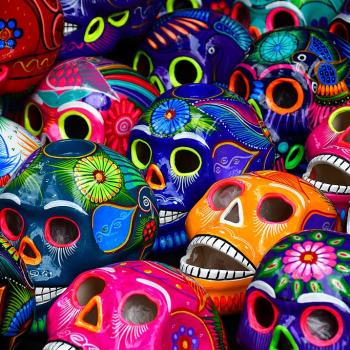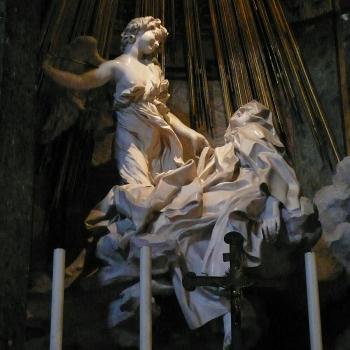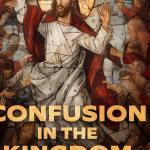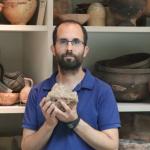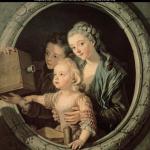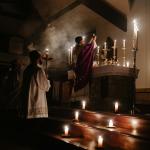Ida, a contemporary black-and-white movie now playing at the E St Cinema & Bethesda Row Cinema, begins as the title character (Agata Trzebuchowska) is about to meet her only known relative. Ida doesn’t want to meet Aunt Wanda (Agata Kulesza), about whom she knows nothing except that Wanda refused to take her in when she was orphaned, so she was raised in a convent. She’s about to take her own vows, though, and so she musters up all her obedience and submits to spending some indefinite time with her stranger-aunt.
Almost the first thing Wanda tells her is that Ida is a Jew. She was given to the nuns to hide her from the Holocaust; Wanda is the only other survivor in her family. Ida’s arrival spurs Wanda to a long-postponed mission–partly driven by love and duty, partly by anger–to find Ida’s parents’ burying place, and restore their bones to a Jewish cemetery.
For me the movie split into three parts. I fully accept that I have my own issues of guilt as a Jewish convert to Catholicism, and the first third of the movie hit those issues hard. Wanda, a former Communist official who hints that she was a hanging judge when she had the power to be, clearly blames Ida for her unchosen Christianity. Ida herself is such a still pond, such a careful and unreadable face, that Wanda is basically the only character we can understand during this part, and Wanda is filled with rage and contempt born of unhealed pain. She makes a lot of cliched, needling comments about Ida’s faith and vocation, and Ida thoroughly unresponds–and at one point actually grabs her Bible out of Wanda’s hands–and I sat there wondering if this would be an hour and a half of two people being awful to one another.
Even in this part, in retrospect, I can see that there were hints of change: The two women confront the family who took over their home when they were kicked out of it, and when they leave, the wife asks Ida to bless her baby. Ida does it, with just the tiniest hint of hesitation, a sliver of irony and shame.
But then Wanda tracks down the man whom she believes to be responsible for Ida’s parents’ murder, and the movie becomes riveting. The haunting black-and-white cinematography comes into its own. The two women’s faces often huddle at the bottom of the screen, with too much empty white space above them–a theological choice as well as a photographic one. The weight of history pressing down on them, the unbearable pressure of everything that they haven’t chosen. Ida holds Wanda, alone together in a big white hospital. The dialogue, which was already sparse but often acute, becomes chilling: “You give up claims to the house and I’ll show you where they’re buried,” a fairly young Gentile man says; and Wanda readily takes the deal. “And you will leave us in peace,” he adds, to make it worse. And then, the final twist: “I know I can trust you, Sister.”
They journey into the woods to find the burial pit, and there are unforgettable shots like something out of one of the old, bloody fairy tales: the two women in the wood; a man crouching in the pit, his arms wrapped around his knees, as Wanda wraps a skull in her scarf and takes it away. Wanda’s expression as she walks away is lost, searching, confused.
You start to see the similarities between the two women: their iron wills, their ferocity, but also their ability to be knocked off-course when they’re no longer battling against those who thwart them.
I don’t want to push this idea too far, since the movie is very personal and not theoretical and anyway this particular abstract point is an exaggeration which is in certain respects misleading, but Judaism and Communism to some extent share an emphasis on the unchosen. The pressure of history, the inescapable context in which we make all our decisions, which we often want to deny so that we can pretend that we own our decisions. Christianity, as a religion of conversion, tends more to emphasize the moment of decision. There are a few stories in the Old Testament of people choosing to become a part of the Jewish people; but the whole New Testament is the stories of people choosing to follow Christ. (This is one reason I suggested that cradle Catholics might look to the Old Testament for models of how to actively accept the faith, the personal relationship with God, into which they entered before they could choose it.) Ida’s decision about her vocation is hers alone, taking place in the ahistorical moment of her encounter with the living God–and yet Wanda’s presence, and the reactions of all the Gentiles she meets on her journey, force her to acknowledge the unwanted history which makes her decision possible.
There’s a terrific moment early on in the movie which captures this clash between choice and context. Wanda’s got a fairly serious drinking… habit, or problem, or artistic expression of survivor’s guilt; anyway she gets picked up for drunkenly driving her car off the road. A police officer asks her, “When did you start drinking?”, meaning, how many hours ago tonight? But she answers, “When I was twelve.”
By the end of this second part of the movie, I pretty much loved Wanda. Unfortunately she then makes a decision which sets the final third of the movie in motion, a third which is entirely about Ida’s choices. And Ida is so opaque that I just could not enter into her decisions and indecisions at all. She goes on a kind of nunspringa, which I admit I found a bit too standard-issue, and she moves from ambivalence toward a final decision about her vocation, and I just can’t get inside her head at all. The final third of the movie felt like watching a marionette be trotted around by the moviemakers.
I don’t know that other people will share my dissatisfaction with the last leg of Ida’s journey. And everything leading up to that was terrific–so powerful, its emotions so earned. It’s a painful movie, beautifully crafted.







